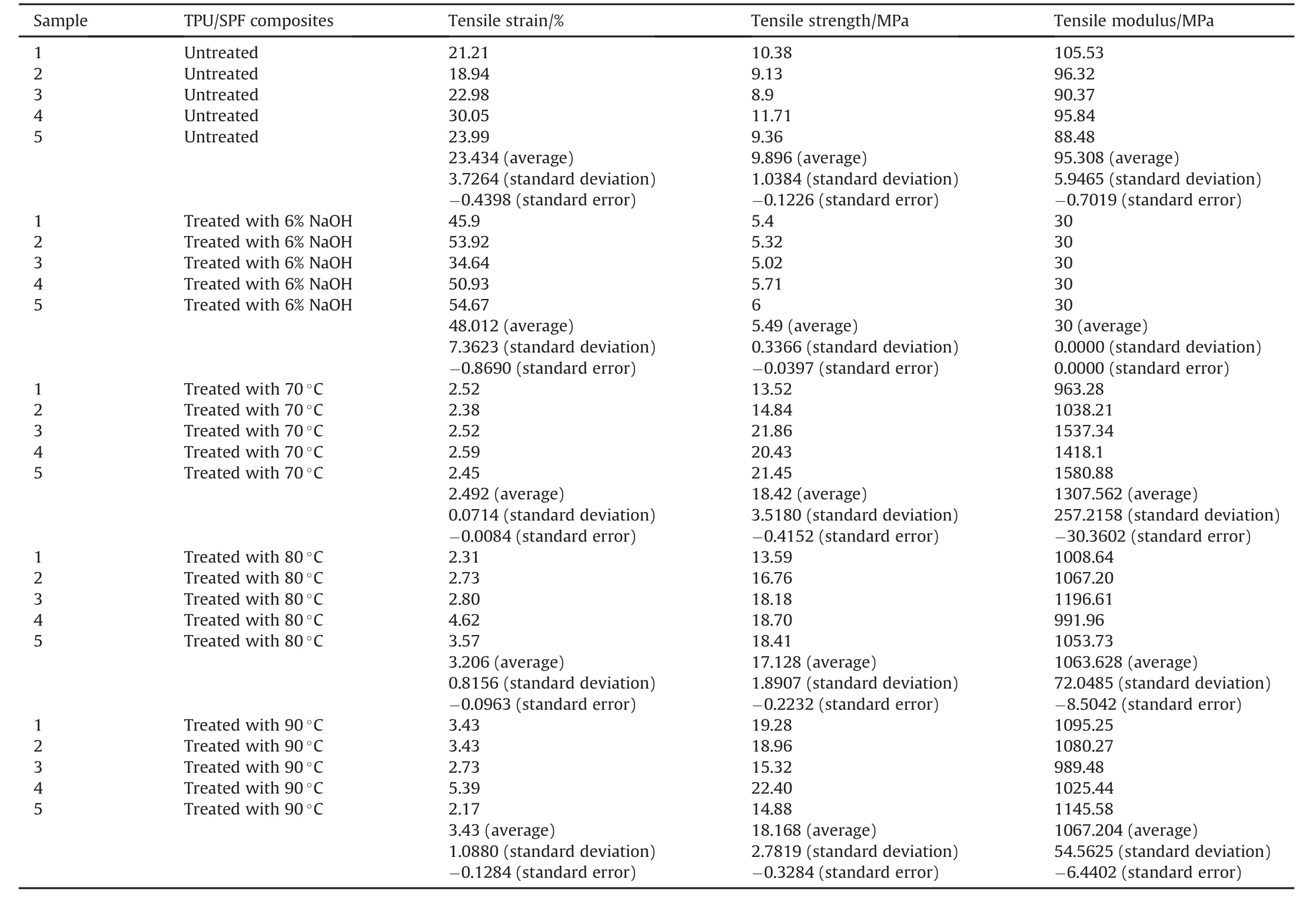Effect of microwave treatment on tensile properties of sugar palm fibre reinforced thermoplastic polyurethane composites
2018-08-25MohmmedBchtirRejbSiregr
A.A.Mohmmed,D.Bchtir,M.R.M.Rejb,J.P.Siregr
aStructural Materials and Degradation Focus Group,Faculty of Mechanical Engineering,University of Malaysia Pahang,26600,Pahang Darul Makmur,Malaysia
bMaterials Engineering Department,University of Technology,Baghdad,Iraq
Keywords:Tensile properties Sugar palm fibre Thermoplastic polyurethane Alkali treatment Microwave method
A B S T R A C T The effect of microwave treatment on the tensile properties of treated sugar palm fibre with 6%NaOH reinforced thermoplastic polyurethane composites was investigated.Firstly,the sugar palm fibres were treated by 6%alkali solution.Then,microwave treatment was used to treat the alkali treated sugar palm fibres.Three types of temperatures(i.e.70,80 and 90°C)were applied in microwave treatment.The extruder and hot press machines were used to mixing the sugar palm fibres and polyurethane resin,and fabricate the composites.Tensile properties(i.e.tensile strength,tensile modulus and elongation at break)were studied by following the ASTM D-638 standard.The highest tensile strength was recorded 18.42 MPa with microwave temperature at 70°C and 6%alkali pre-treatment.Therefore,the temperature 70°C of microwave treatment may consider the best degree cent grate.
1.Introduction
Nowadays,it is important to reduce consume the petroleum product to preventor reduce the environmental impacts.Moreover,to decrease the materials coast by using different natural resources such as the natural fibre.Many industrial fibre like the fibre glass and carbon fibre have good mechanical properties but with high production fees.Therefore,the natural fibre consider a good resource and it has unique characteristics and many outstanding advantages over synthetic fibre,which make it an attractive alternative to traditional materials.
Natural fibre-reinforced plastics are gaining more attention from researchers and industry due to cost effectiveness,a lighter weight,lower abrasion of equipment and renew ability among the benefits of natural fibre composites.For those reasons,it is used in construction and the furniture,automotive and packaging industries[1].Natural fibre such as flax[2],sugar palm[3],henequen[4],hemp,sisal,jute,and kapok Fibres[5],pineapple leaf[6],ramie[7],kenaf[8],oil palm[9],has been reported as being used as fibre in polymer composites[10].However,the natural fibre has hydrophilic nature.This nature makes it has less ability toadhere with the polymer due to the hydrophobic nature of the polymer[11,12].Because of that there were many schoolers studied how to reduce this nature of the natural fibre.There are chemical and physical methods were used to solve this problem.
This problem may be rectified by chemically treating the fibre surfaces before fabricating the composites[13-15].Alkali treatment is an important chemical treatment method used to enhance interfacial adhesion between natural fibre and polymer as well as the mechanical,physical and thermal properties of fibre[16].
Physical treatments change the chemical,structural and surface properties of the fibre surface and thereby influence the mechanical bonding with the matrix polymer.Surface modification by microwave treatment is of great interest because of their environment friendly nature.Microwaves are electromagnetic waves that lie between radio and infrared frequency regions in the electromagnetic spectrum.Depending on the materials,microwaves are generally reflected,transmitted or absorbed.
The ability of certain materials to convert microwaves into heat makes these materials suitable for microwave processing[17].In microwave heating,the material will absorb microwave energy and then convert it into heat.In previous studied microwave heating of cotton fibers during mercerization reduces the values of concentration of NaOH in the aqueous solution and the time of treatment that are needed for the complete transformation of cellulose lattice type I into cellulose lattice type II without any heating[18].
Thermoplastic polyurethane TPU has been chosen due to its good mechanical properties and rubber-like elasticity.Moreover,it is polar,which reduces the fibre polymer incompatibility[19].Sugar palm fibre SPF is a potential source of natural fibre from Arengapinnate,a member of Palmae family.It is known as a fast growing palm that is able to reach maturity within 10 years[20].This plant commonly grows in tropical regions such as the Philippines,Malaysia and Indonesia.It is naturally a forest species.The sugar palm fibre remains largely unknown by many people and very little information is available about it,more research needs to be conducted to unveil its significance and to promote its usefulness for the benefits of the public[21].
Thus,the present work studied the effect of different temperature of microwave from 70,80,to 90°C on the fibre-matrix adhesion of TPU and SPF.Tensile properties of the composites were measured according to ASTM standard D638[22].To the best of the researchers' knowledge,TPU/SPF composites have not yet been investigated by other researchers.
2.Materials
The materials that were used in this study are sugar palm fibre(SPF)and Estane®58311 is a 85 A Polyether-Type Thermoplastic Polyurethane(TPU).The specific gravity of the TPU is 1.21.The melting temperature is 210°C.Pellets are sodium hydroxide(NaOH).
3.Methods
3.1.Preparation of fibre
The fibre was washed by water to remove dust and some impurities,then dried for two weeks in the room temperature and atmosphere pressure.Afterward they were crushed by grinder machine Retsch ZM 200,subsequently were shortened to a suitable size by sieving to size of 250μm[23],by using an auto shaker type FRITSCH in order to make them suitable for the final application[23-26].
3.2.Treatment of fibre
The hydrophilic nature of the SPF makes the adhesion between it and the hydrophobic TPU poor.This nature causes the weak in the structure of composites[25].The ETHOS E microwave was used to solvent treatment at power 340 W and three different temperatures(as 70,80,to 90°C).Before socking the solution leaved until to be stable and the temperature changed to the room temperature around 30 min.So,the clean,dried,and grinded fibre was washed eight times by using distilled water,after soaking it into 6%sodium hydroxide solutions for 90 min inside the microwave[1,27].After that,the fibre was left to dry for around two weeks in the atmosphere pressure and room temperature[1].
3.3.Composite preparation
TPU/SPF composite specimens were compounded using a Thermo SCIENTIFIC EUROLAB 16 extruder machine.The optimum rotating speed and temperature were set as 40 rpm,and 180-190-200°C[23].The author did previous work studied the different fibre loading on the mechanical properties for the TPU/SPF composites.The result proved that the best mechanical properties at 10% fibre in 90%TPU[25].However,the 10% fibre loading is very little and it is nothaving feasibility.So,A 30% fibre loading was fixed throughout the study at 250μm fibre size.The fibre was treated with 6%concentrations of NaOH.A 30% fibre weight mixed into 70%TPU was extruded in extruder machine under optimum conditions of 180-190-200°C and 40 rpm[23].Then extruded composite pellets were pressed by using square mould afterward using the hot press LOTUS SCIENTIFIC 25 ton compression molding by setting the press pressure at 10 MPa and 190°C for 10min[28].Prior to the full pressure the sample was pre-heated until reaching 190°C.Then the prepared sheet was cooled till 50°C.A stainless steel mold with dimensions of 200×200×3 mm,length,width and thickness respectively was used.
3.4.Mechanical tensile testing
Tensile strength is a measurement of the ability of material to withstand forces that tend to pull it apart.It determines to what extents the material stretches before breaking.Tensile properties were measured using an Instron 3369Q3720 machine,according to ASTM D 638[22].The specimens were prepared by cutting them into dumbbell shapes using a manual saw.Five specimens were tested with a crosshead speed of 5 mm/min.Tensile specimens are shown in Fig.1.The accurate results build not only on the testing system but also on the errors that can be inserted into it.Thus,Table 1 exemplifies the tensile strength,modulus,strain,and the statistical analysis,such as the average,standard deviation and error for the untreated and treated TPU/SPF composites,well arranged to know the range of accuracy.
4.Results and discussions
4.1.Effect of microwave treatment on the tensile strength of TPU/SPF composites

Table 1 Tensile strain,strength,modulus,average,standard deviation and error for the untreated and treated TPU/SPF composites with 6%NaOH and Microwave.
Fig.2 estimate the effect of microwave treatment temperatures on the mechanical properties of bio-composite TPU/SPF.The tensile strength was 18.42 MPa,17.128 MPa and 18.168 MPaat 70°C,80°C and 90°C respectively.Where the values of tensile strength are improved with temperature of treatment with optimum values at 70°C reached 18.42MPa,because this type of treatment is cleaned the fibre surface,also modified the chemistry on the surface,after word lower the moisture up take and finally increased the surface roughness,Where the natural fibres bear hydroxyl groups from cellulose and lignin are reducing the activity towards the matrix,and this modifications may activate these groups to introduce new moieties that effectively lead to chemical interlock with the matrix for improving fibre strength, fibre fitness and fibre matrix adhesion[14].The strength for untreated TPU/SPF recorded around 10MPa.However,it decreased for treated TPU/SPF to about 4.5 MPa.On the other hand,the treated TPU/SPF under the microwave action reached the highest value of about 18.5 MPaat 70°C.The standard deviation for treated fibre was the highest value if compared with the untreated value as illustrated in Table 1.Moreover,the standard error for treated fibre recorded the maximum values if they compared with the untreated values as illustrated in Table 1.
4.2.Effect of microwave treatment on the tensile modulus of TPU/SPF composites
Fig.3 shows the modulus is decreasing with increasing of temperatures,then the values of modulus at 70°C low treatment temperature is 1307.562MPa reached to 1067.204 MPa for 90°C temperature treatment.It was clear that the modulus enhanced after the NaOH treatment with microwave action.However,the microwave treatment recorded the highest tensile modulus value is about 1307.562MPaat 70°C.The reason behind that the microwave remove all the NaOH residue from the fibre to make it more rough and less moisture and with good hydrophobic properties[29].
4.3.Effect of microwave treatment on the tensile strain of TPU/SPF composites
Fig.4 shows the results for tensile strain which was recorded the highest values of 3.43%,3.206%and 2.492%at 90°C,80°C and 70°C.It was clear that the tensile strain witnessed a dramatic went down because of the enhancing in the bonding between the fibre and matrix[2].On the other hand,the tensile strain for the untreated and treated fibre recording the higher value if compare with microwave treatment.
5.Conclusion
It could see that the microwave technique gives excellent tensile properties than both 6%NaOH and untreated TPU/SPF composites.Treatment method according to the pull out all waxy and impurities.In addition,to dropping the excess moisture that may be effect on the final tensile properties and potential interfacial bonding.
杂志排行
Defence Technology的其它文章
- Conceptual design of automobile engine rubber mounting composite using TRIZ-Morphological chart-analytic network process technique
- Evaluation of stiffness in a cellulose fiber reinforced epoxy laminates for structural applications:Experimental and finite element analysis
- Hybrid reinforced thermoset polymer composite in energy absorption tube application:A review
- Friction surfacing of AISI 316 over mild steel:A characteriation study
- Experimental and simulation studies on delamination strength of laminated glass composites having polyvinyl butyral and ethyl vinyl acetate inter-layers of different critical thicknesses
- A review on machinability of carbon fiber reinforced polymer(CFRP)and glass fiber reinforced polymer(GFRP)composite materials
